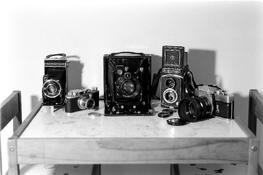That's nice, but ... The focusing panel appears to be for 2x3 (6x9 is a poor metric approximation). One of your photos shows of the final design with what appears to be a 2x3 roll holder for a 2x3, not a 4x5, camera. If it really is a 2x3 camera, the normal focal length for the format is 100, not 150, mm. Your photos show your camera in portrait orientation. There doesn't appear to be a way, without external bracketry, to put it on a tripod in landscape orientation. It appears to be a fixed lens camera; I suppose that lens cones for different focal lengths are possible.
The original design appears to be for 4x5. Why did you abandon that?
Please tell me why I should replace my relatively inexpensive humble 2x3 Graphics, which have tripod sockets for landscape and portrait orientation and accepts focal lengths from 38 mm to 250 mm without the expense and bulk of lens cones, with a Milo Monolith.
Hi Dan,
I’m a big fan of old 9x12 cm field cameras from the turn of the century to the 1940s. I’ve owned many of them in my collection, some in almost mint condition, while others were completely ruined. These cameras and their lenses are a technical masterpiece of their time. Unfortunately, they are not very usable today due to the limited film selection, the difficulty of loading film, and the fragile holders, which are far inferior to the 4x5 Fidelity holders. However, the lenses are often of exceptional quality and have their own unique charm.
My goal was to continue using these lenses, so I bought a 4x5 Intrepid camera. On my first attempts with the camera, I realized that the setup and adjustment process was so time-consuming that I quickly lost interest. I wanted to have large negatives, the ability to shoot on glass plates, and, of course, to use the lenses I had collected over the years.
I came across the Wanderlust camera and thought it might be the perfect solution. However, it became clear to me that the Wanderlust design couldn’t be modified and adapted to my needs, and the printed helicoid wasn’t quite what I was looking for. That’s when I decided to design something of my own.
I achieved my goal with the following key features:
Portrait Orientation: Almost all 9x12 cameras from the early 1900s were used in portrait mode. Sure, you can buy an L-bracket and use the Milo Monolith in landscape mode, but personally, I shoot about 90% of my images in portrait orientation.
Robustness and Weight: The camera was intentionally designed with thick walls and a 100% filled print. I wanted it to be heavy for stability. Light 4x5 cameras with bellows are unstable when there’s a bit of wind. The Milo Monolith is heavy and offers better resistance to camera shake, reducing the risk of motion blur.
Lens Compatibility: The lenses used on 9x12 cameras typically range from 130mm to 150mm. My goal was to design a conical shape and dimension that would allow me to use as many of these lenses as possible. I succeeded in this – all the lenses in this range from my collection work perfectly, providing full coverage of the 4x5 negative from around 1 meter to infinity. The cone doesn’t change, only the helicoid does. For my Dagor 130mm, I use a 17-30 helicoid, while all other lenses work with a 25-55 helicoid.
Graflok Back: I also integrated a Graflok-style back, allowing me to use Horseman 4x5 backs for 6x9/6x7/6x6 film formats. At the same time, I created several masks to help frame the image perfectly. I enjoy using roll film because, firstly, it gives me a slightly different – and sometimes useful – focal length. A 150mm lens on roll film (6x9) behaves like a 65mm lens on full-frame. Secondly, it allows me to shoot color photographs more affordably. The longer focal length helps me achieve better subject isolation.
The back also features a Fresnel lens, which wasn’t available on cameras back in the day.
Monolithic, Bellows-Free Design: This design makes it possible to set up the camera very quickly, take the shot, and move on. When I’m on a hike with my family, I don’t have the luxury of stopping for 20 minutes to set up a shot. Often, you’re not even allowed to use a tripod, and you have to shoot handheld. With an external viewfinder, this becomes entirely possible.
As you can see, the Milo Monolith is a highly versatile camera/platform that allows you to continue using the great old lenses from traditional field cameras.
This camera will not replace your current 4x5 bellows camera, but it is an excellent complement for certain situations.
Lastly, I’ve had enough of discussions with passersby about my photography. The longer I stay in one place, the greater the chance of someone approaching and engaging in a conversation that I really don’t want to have.













